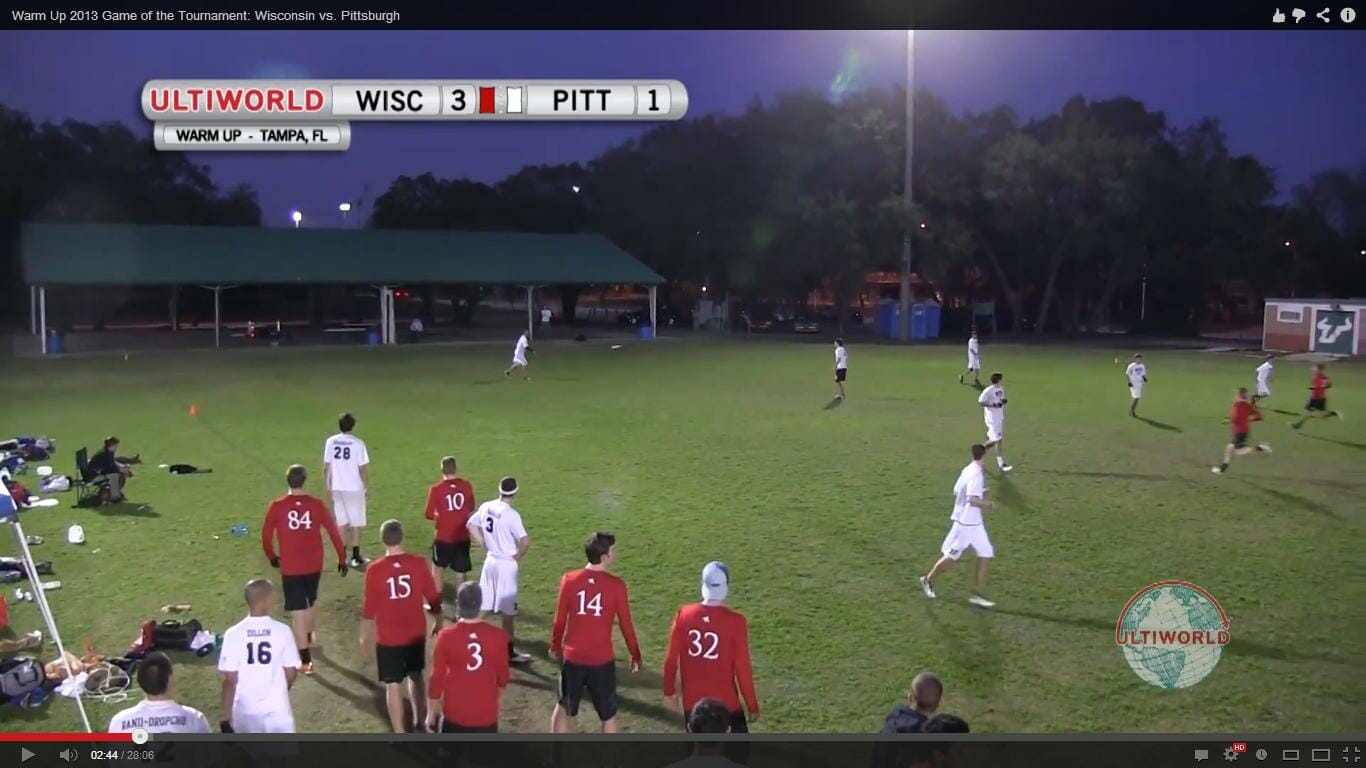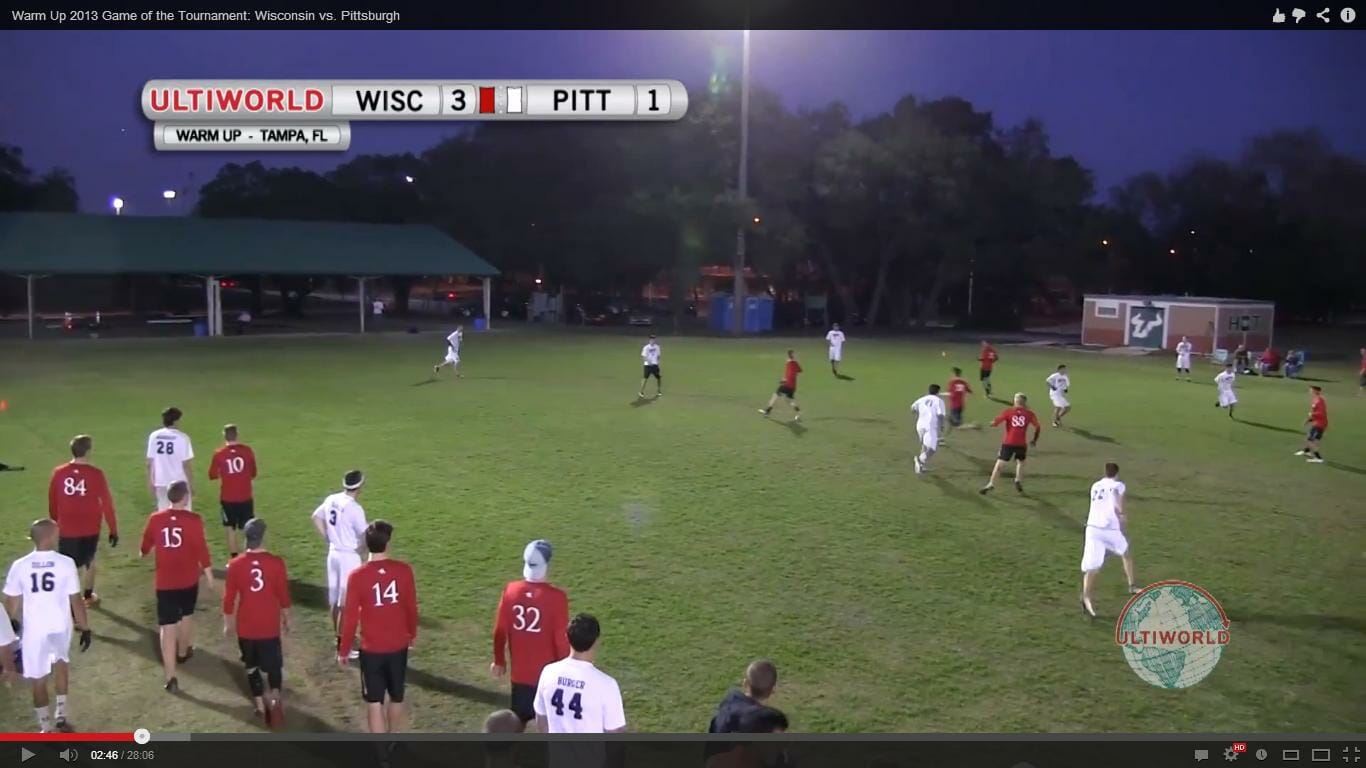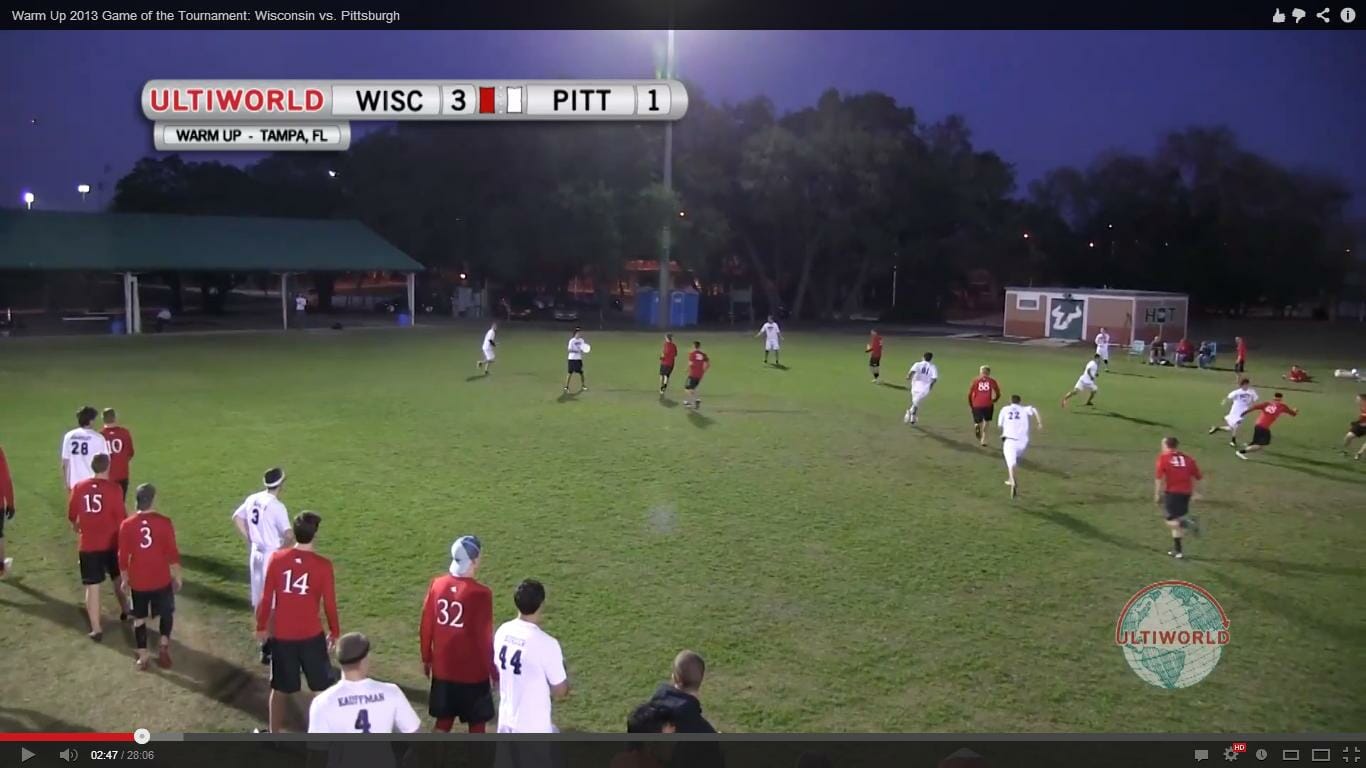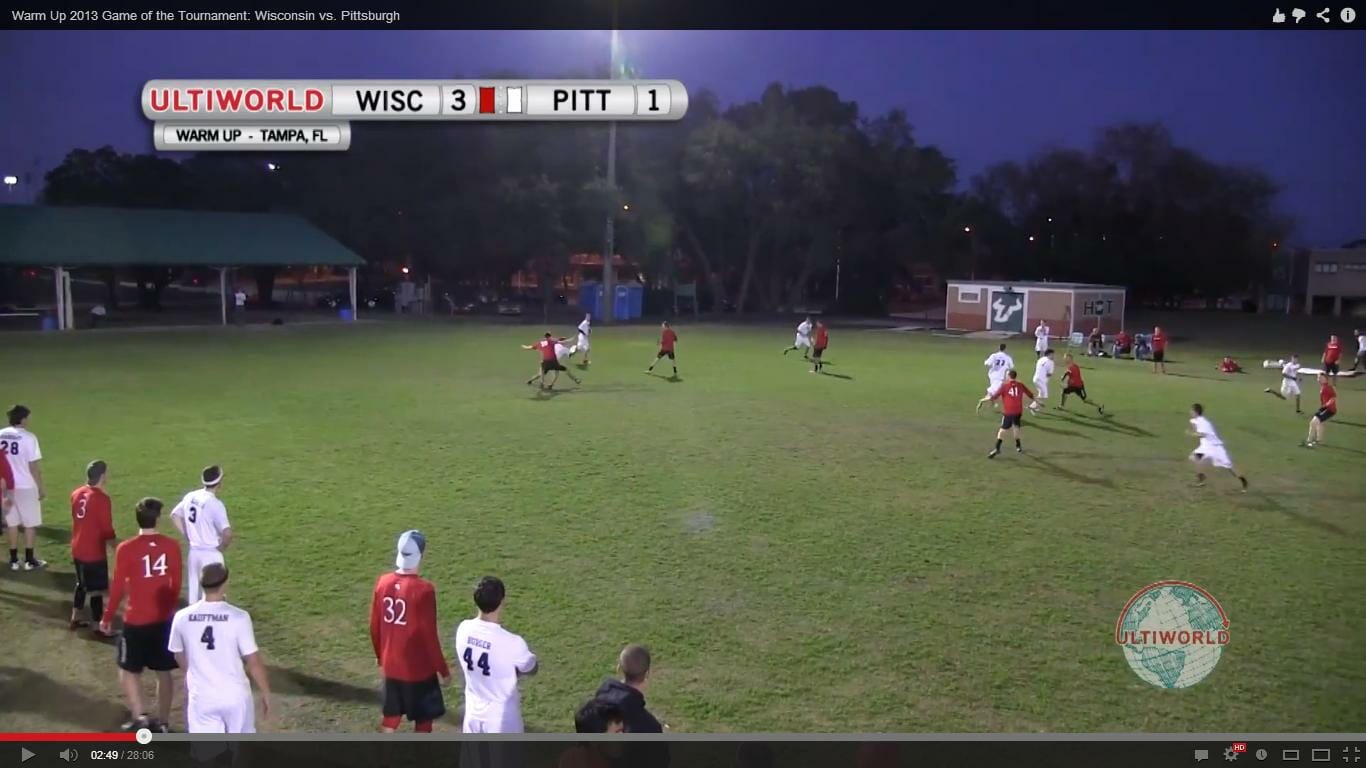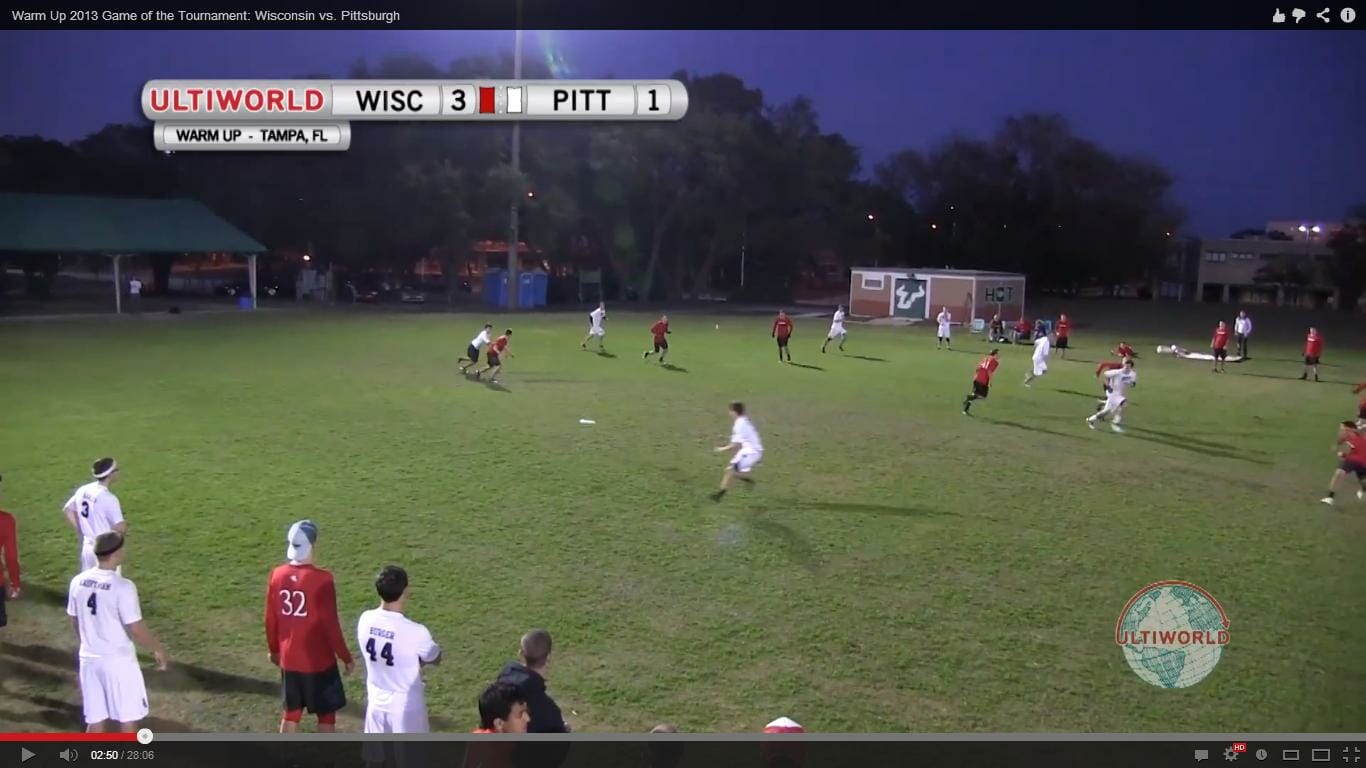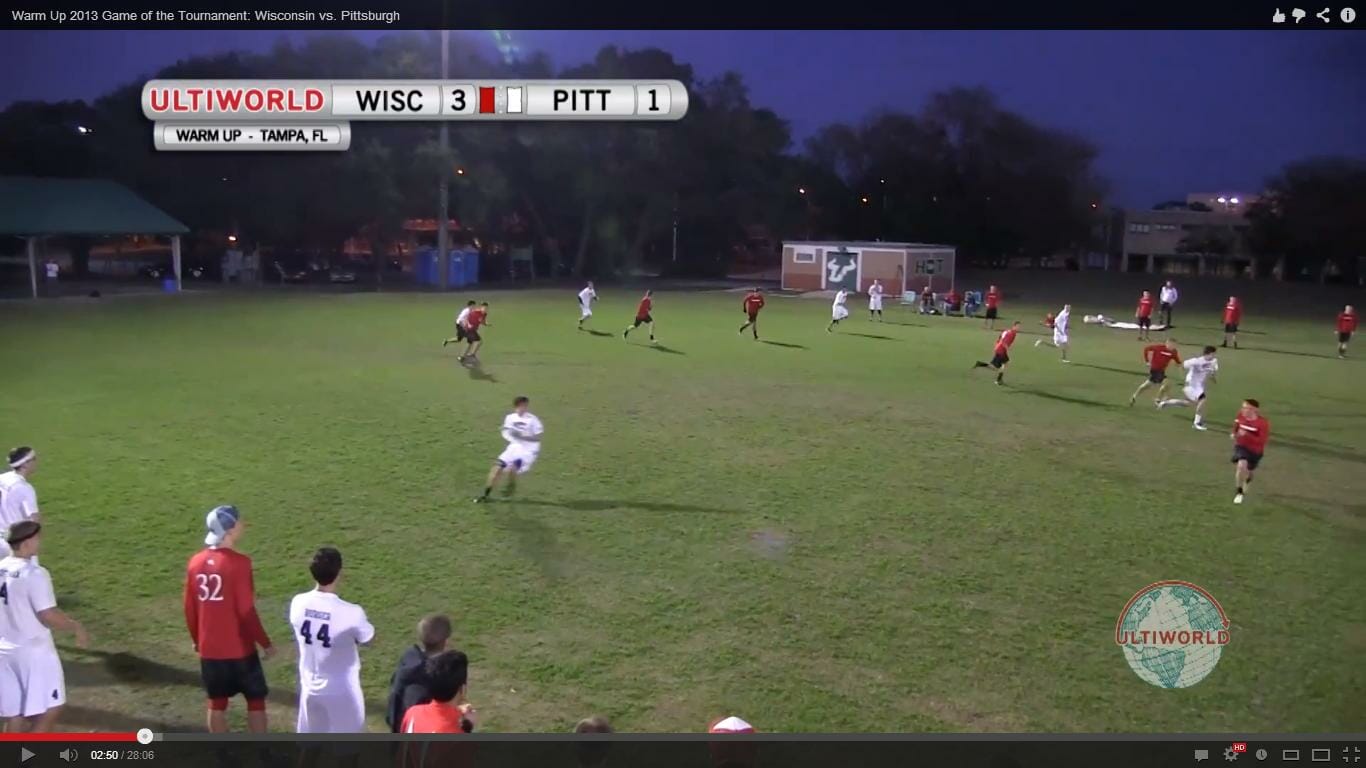April 2, 2013 by Glenn Poole in Analysis with 2 comments
[youtube I-DNvHNnMSw 600 377]
Before the start of the spring season, Ultiworld slotted the defending Division I champion Pittsburgh as the frontrunner for this year’s college title. It was also no surprise to see Wisconsin, last year’s runner-up, and the other two 2012 semi-finalists, Carleton and Oregon, near the top of the preseason rankings. After the last few weeks of college action, we’ve seen a much greater level of parity than in recent history, but each of those teams remains in the top 10 and with a viable shot at this year’s National Championship.
After following the results from Florida’s Warm Up and the Stanford Invite, I decided to take a closer look at some of the footage we had of these teams. I was hoping to get a little insight into what, at the highest levels of the college game, separates a win from a loss. It’s a question that I do not expect to be able to answer definitively, so in order to tighten the focus I started with two games between two front-runners, Pittsburgh and Wisconsin.
Both games were arguably meaningful, not only because they were rematches of last year’s finals but also because of context: one was a showcase game, the other a semifinal. Wisconsin won both contests, by two and four points respectively, and Pittsburgh coach Nick Kaczmarek suggested that his team “struggled to make adjustments, particularly in semifinals.” Why was Wisconsin so successful against the defending champs, and how were they able to press their advantage in their second matchup? First, it might be worth pointing out another Kaczmarek quote: “We are not defending champions. The defending champion is Pitt 2012. This is Pitt 2013.” I respect this attitude and to a great extent it is true, but Pitt 2013 still has the two top players, Alex Thorne and Tyler DeGirolamo, returning for their fifth seasons along with a crop of strong role players. A completely different team it is not. Similarly, Wisconsin has benefited from the coaching of former Hodag Hector Valdivia, bringing extra stability to their program despite “tough roster turnover” this year.
That being said, I am much more interested in analyzing the team than its players, and will therefore focus on two things: how well Wisconsin and Pittsburgh move the disc on offense, and how well each team disrupts their opponent’s flow with defense. These are necessarily broad categories, so let me define two terms. For the purposes of this article, “flow” will be defined as a team being able to connect at least two passes in a row without giving the defenders enough time to regain their positioning. “Stagnation” is the essentially the opposite: a lack of movement, of offensive players or the disc, which gives defenders the opportunity to regain positioning and pressure the offense. Note that a thrower holding the disc for a long time does not necessarily indicate stagnation: actively anticipating a play as it develops may be a part of creating flow.
Getting to the above game tape, both teams start out firing on all cylinders. Wisconsin kicks off the showcase game with a pair of breaks, capitalizing on turnovers from excellent defensive plays. Both offensive possessions are excellent examples of what I mean by flow. For the first break they work it up a full seventy yards with seven passes in less than twenty seconds, an impressive sequence, and in the second point they shut down all of Pittsburgh’s downfield options before making a big play on the around swing, then take the time to set up a redzone play.
That play is a good example of what I would call deliberate flow: after getting the disc with momentum to the break side, the thrower threatens break, pauses a beat to let the continuation cut develop, and then fires an inside-out flick for the score. Pittsburgh responds with a quick one-two isolation play and huck, Wisconsin answers with a great pull play, and Pitt comes back with one of their own.
This is where it gets interesting. At 2:44, the Pittsburgh cutters all come out in a horizontal stack, then push in unison to the sideline as the disc is centered, creating an isolation play. Two Hodags have the chance to break it up: the mark that gets broken, and #41 with a brief window to poach in the break lane. You can see the play developing below:
If you slow the video down you can see #41 considering the poach before drifting over to the stack, leaving the Pitt cutter wide open on the break side with a deep option and time to throw. My first thought was hey, great flow—but the way Pitt set up this play tells us a lot about the way they play in general, and how Wisconsin is able to take advantage of that.
The play takes a relatively long time to develop. The action doesn’t start until the swing is caught, and then the isolated cutter has to wait for everybody else to clear out of the way. That gives Wisconsin a lot of time to react to the play. If #41 had not hesitated, they could have forced a turn, or at least prevented the easy score.
In games between top competitors, evenly matched opponents, sometimes the difference is as small as that. With four break points total from Wisconsin, Pittsburgh gets three of them back; aside from a few big skies from the Hodags, neither team manhandles the other. What I see as the key difference is that Wisconsin scores more quickly, and with fewer passes, whereas Pittsburgh has to work harder for each point.
If you only watched a highlight reel from this game, you might think the Hodags score more easily because they take more aggressive deep shots—and make up for poor ones with big plays. Between athleticism, skill, and strategy, sometimes an abundance of one can make up for deficiencies in another. But even if Wisconsin is the more aggressive team, patience isn’t Pittsburgh’s problem: it’s how they go about being patient. All too often we see Pittsburgh cutters congregating in the center of the field, waiting for the disc to move before making a cut. The Pitt handlers generally do a great job of swinging the field, but their cutters are often stagnant. Instead of anticipating the swing and setting up continuation cuts from motion, the downfield players give defenders the time to regain good positioning. The Hodags are able to play more closely because Pitt plays more predictably.
This ties in to the Pittsburgh pull plays, which tend to take longer to develop than Wisconsin’s. Because Wisconsin has more time to anticipate the action, they are able to bait a layout block on a pull play late in the showcase game (22:38). The Hodags then capitalize on a short field to break and go up 12-10, bringing it to game point. But the particular block here is really the result of an entire game’s worth of adjustment and pressure.
Though Pitt does score more often than not, it takes them a lot more effort to do so. Wisconsin, on the other hand, may cut more aggressively and expend more energy per player in a given moment, but the Hodags score more efficiently overall. Receiving at 8-6, their pull play breaks down but solid handler movement gives them a decent deep option, even if it doesn’t quite connect—an aggressive turnover, but a calculated risk. When Pittsburgh checks it in at 14:16 we see very little movement from the cutters, who either stand in one spot or jog out rounded cuts while the handlers move the disc between each other. Finally #42 breaks free for a deep score, but really only gets open because his defender got picked. Obviously a team has to execute in order to put points on the board, so it’s tempting to call this point a win for Pittsburgh. But to cannibalize a concept from sabermetrics, you don’t have to score every point or win every matchup in order to win the game. You just have to score more breaks than the other team.
Despite Wisconsin’s many turnovers, they do successfully execute their game plan. You might even say that their miscues don’t really detract from that goal because after each turn, strong defense keeps Pitt from converting very easily. Even though Pitt does get to the endzone frequently, in offensive and in defensive points, they rarely do it easily. In the end, I suspect that the cumulative effect of Pittsburgh’s difficulty in moving the disc wears them down, and I think this is a big part of the Wisconsin wins. But if we are to credit Hodag defenders with stopping their opponents, we also have to recognize that Pittsburgh creates their own stagnation.
In the second half of their semifinal matchup (available in the Ultiworld video store), neither team scores with much ease. Pittsburgh chips their way downfield with a thrower-led offense, cutters often waiting on handlers to initiate. Wisconsin also relies a lot on their handlers to keep things moving, but the difference is how they tend to set up more continuation cuts from motion. Down 10-12 and pulling, Pittsburgh initially does a good job of slowing Wisconsin down. The teams trade deep turnovers. But then when Pitt gets it back, they throw handler pass after handler pass and stare at a bunch of stationary receivers.Finally one of those handler passes is wayward enough to get blocked, so Wisconsin gets the turn and fast-breaks downfield to score in flow.
Next point, the lack of downfield options allows Wisconsin to ramp up pressure on the Pittsburgh handlers; Pitt throws another turnover and this time right on the goal line. Wisconsin scores with another fast-break.
“They outmatched us defensively and in offensive fundamentals in both games,” Pittsburgh coach Kaczmarek said of their losses. I wouldn’t say that the Pittsburgh players were outmatched in fundamentals, though, at least not in throwing and catching. They are clearly talented, they make some great plays, and their patience—a commonly lauded offensive trait—is probably better than Wisconsin’s. But the way they set up their cuts, or fail to do so, gives Wisconsin defenders the time to regain their positioning.
If there is a meaningful insight I take from these two games, it’s that a team can make their opponents look really great by letting them do what they want to. When your opponents are already some of the best defenders in the college game, it probably isn’t a good idea to make their job even easier. If Pittsburgh could have adjusted better in the semifinals, it’s because they could have identified how their offense was letting the defense play good defense. Maybe this is a long article to make sure a small point, but like I said: at this level of the sport, the difference between a win and a loss isn’t that big.
